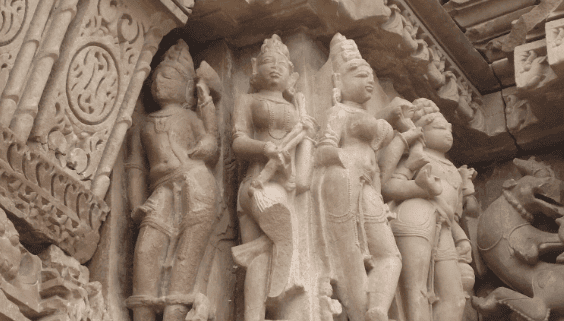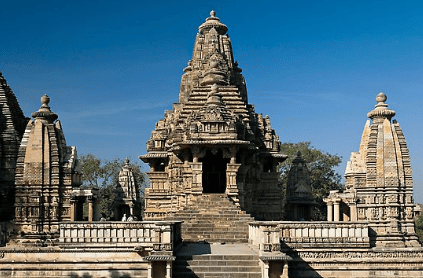Temple Architecture: Khajuraho | History Optional for UPSC PDF Download
Introduction
Early medieval temples in central India, built by the Chandela rulers between the 10th and 12th centuries in Khajuraho (Bundelkhand region), showcase the peak of Nagara architectural style.
According to local tradition, there were originally 85 temples in Khajuraho, but today only 25 remain. These include:
- Ten temples dedicated to Vishnu in various forms.
- Eight temples dedicated to Shiva.
- One temple dedicated to Surya.
- One temple dedicated to the Chaunsath Yoginis.
- Five temples dedicated to the Jaina faith.
Notable examples include:
- Kandariya Mahadeva Temple (dedicated to Lord Shiva)
- Lakshman Temple and Chaturbhuja Temple (dedicated to Lord Vishnu)
- Chitragupta Temple (dedicated to the Sun god)
- Adinatha Jain Temple
Two phases of temple construction are observed:
Phase I: Primarily using granite. Important temples include:
- Chausath Yogini temple
- Varah temple
- Brahma temple
Phase II: Primarily using sandstone. Important temples include:
- Lakshman temple
- Vishwanath temple
- Parswanath temple
- Kandariya Mahadev temple
The Khajuraho temples represent the zenith of central Indian architectural style, exhibiting unique features in their design and structure.
- Most temples are built from fine-grained sandstone.
- They are compact and tall, without enclosure walls, and are raised on a high platform terrace (jagati), which elevates the temple and provides a surrounding promenade.
- The jagati is followed by the jangha or wall section, adorned with bands of sculptures.
- The temples display a highly integrated, compact, and unified structure with a rectangular ground plan.
- A notable feature is the Nagara shikhara, consisting of several miniature shikharas called urisingas. The crowning amalaka is often likened to a lotus or a solar halo with rays, symbolizing the path to heaven.
- Many temples follow the "Panchayatana" system, where the main shrine is surrounded by four subsidiary shrines at the corners.
Examples include:
- Lakshmana temple
- Vishwanath temple
- Chaturbhuj temple
Internally and externally, the compartments of the temples are interconnected along a single axis, typically east-west.
In general, the temple structure in its compact form consists of four sequential parts:
- Mukha-mandapa
- Mandapa
- Antarala
- Garbha-griha
In larger temples, lateral transepts with balconied windows are added to the mandapa, transforming it into a maha-mandapa. The presence of pradakshinapatha and intricate carvings around the inner and outer pradakshina are also notable features.
The superstructure of the Garbhagriha is curvilinear (Rekha Shikhara), while other parts have pyramidal structures. Each part has a separate roof that rises in order, creating a rhythmic accentuation.
The shikhara consists of:
- Jangha
- Chhapra
- Amalak
- Kalash

In some cases, there are two amalakas: a lower (larger) and an upper (smaller) amalaka.
- Interior view of the shikhara ceiling exhibits a symmetrical layout.
- Temples generally follow a seven-ratha plan, where the sanctum is saptaratha in both plan and elevation.
- The cubical portion beneath the shikhara is divided into seven segments (saptanga-bada), featuring two series of mouldings at the basement and three sculptured registers on the jangha, separated by two sets of bandhana mouldings.
- Temples are not astylar, meaning they have pillars instead of piers, and the halls are open types.
- The immense appeal of the Khajuraho temples lies in their proportions, contours, and the vibrancy of the ornamental images throughout.
About 10% of the carvings depict sexual themes, while the rest portray everyday life scenes such as:
- Women applying makeup
- Playing games
- Dancing
- Knotting and unknotting girdles
- Other themes like musicians, potters, farmers, etc.
These large platforms feature intricately carved depictions of contemporary life. The large-scale depiction of horsemen in the sculptures at Khajuraho indicates the decline of horse-drawn chariots and the increasing emphasis on cavalry, with some sculptures also showing the use of saddles.
The sculpture art in Khajuraho temples is more refined, graceful, elegant, and profuse compared to that of Odisha temples, with ornamentation present on both exterior and interior walls.

Most important surviving temple
- Among the surviving temples, the Kandariya Mahadev temple, built in the 11th century and dedicated to Lord Shiva, stands out. It is adorned with a multitude of sculptures featuring intricate details, symbolism, and expressiveness characteristic of ancient Indian art.
- The temple is set on a high platform and comprises a porch, mandapa, maha-mandapa, garbhagriha, and pradakshinapath. The shikhara of the temple symbolizes Mount Kailash, the abode of Shiva, and is topped with eighty-four smaller shikharas.
Temples, religious affiliations and consecration years
- Chausath Yogini(Hinduism) - Devi, 64 Yoginis - Completed in 885 CE
- Lalgun Mahadev(Hinduism) - Shiva - Completed in 900 CE
- Brahma Temple(Hinduism) - Vishnu - Completed in 925 CE
- Lakshmana Temple(Hinduism) - Vaikuntha Vishnu - Completed in 939 CE
- Varaha Temple(Hinduism) - Vishnu - Completed in 950 CE
- Parshvanatha Temple(Jainism) - Parshvanatha - Completed in 954 CE
- Ghantai Temple(Jainism) - Adinatha - Completed in 960 CE
- Mahishasuramardini Temple(Hinduism) - Mahishasuramardini - Completed in 995 CE
- Vishvanatha Temple(Hinduism) - Shiva - Completed in 999 CE
- Matangeshwar Temple(Hinduism) - Shiva - Completed in 1000 CE
- Vishnu-Garuda Temple(Hinduism) - Vishnu - Completed in 1000 CE
- Beejamandal Temple Ruins(Hinduism) - Shiva - Completed in 1000 CE
- Ganesha Temple(Hinduism) - Shiva - Completed in 1000 CE
- Devi Jagadambi Temple(Hinduism) - Devi, Parvati - Completed in 1023 CE
- Chitragupta Temple(Hinduism) - Sun, Chitragupta - Completed in 1023 CE
- Adinath Temple(Jainism) - Adinatha - Completed in 1027 CE
- Shantinatha Temple(Jainism) - Shantinatha - Completed in 1027 CE
- Kandariya Mahadeva Temple(Hinduism) - Shiva - Completed in 1029 CE
- Vamana Temple(Hinduism) - Vamana - Completed in 1062 CE
- Javeri Temple(Hinduism) - Vishnu - Completed in 1090 CE
- Chaturbhuja Temple(Hinduism) - Vishnu - Completed in 1110 CE
- Duladeo Temple(Hinduism) - Shiva - Completed in 1125 CE
Lakshmana temple:

- Located in Khajuraho.
Vishwanath temple:
- Features sculptures of a loving couple, Dancing Ganesha, Parvati, a flute-playing woman, and Shiva Linga, among others.
Parswanath temple:
- Adorned with sculptures of Jain deities on the walls, Apsaras with Vishnu-Lakshmi, various Goddesses, and a Magic square inscription.
Kandariya Mahadev temple:
- Notable for its main temple tower featuring 84 mini shikharas, showcasing intricate architectural details.
|
367 videos|995 docs
|
FAQs on Temple Architecture: Khajuraho - History Optional for UPSC
| 1. What is the significance of the Khajuraho temples in Indian architecture? |  |
| 2. How many temples are there at Khajuraho, and what are their main features? |  |
| 3. What are the primary religious affiliations represented in Khajuraho temples? |  |
| 4. When were the Khajuraho temples consecrated, and what was their historical context? |  |
| 5. What are the unique architectural features of the Khajuraho temples? |  |
















